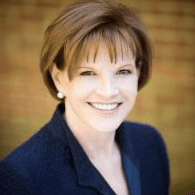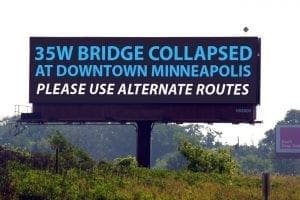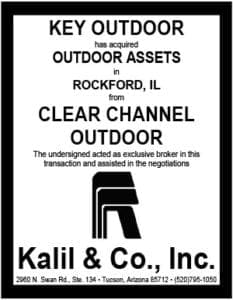 By Nancy Fletcher, OAAA President and CEO
By Nancy Fletcher, OAAA President and CEO
Twenty-five years ago, I signed a contract to lead OAAA (October 1991). A few months later, my husband and I moved our family from Minnesota to Washington, DC.
Thinking back on a quarter century, I’ve assembled a list of 25 highlights in 25 years (scroll down for full list). From then till now, working together, we’ve made real progress:
- Advertising revenue reports used to put our medium in the “other” category, if it was mentioned at all. Now OAAA is a central source for OOH revenue reporting (and is cited by The New York Times and other reputable press outlets.)
- We used to avoid the press (or run). Now we embrace the press, ready to tell our story. The New York Times just published an article urging the world to “Look Up” to see the innovations in OOH, and Ad Age Creativity magazine just covered the industry’s Vote to Count campaign.
- Naysayers wrote us off in hard times. But we were resilient through recessions (2008-09), terrorists’ attacks (2001), and the loss of tobacco advertising (1998-99).
 We used to reluctantly work with government. Now we are partners to the FBI, the US Marshals Service, FEMA, and the National Center for Missing & Exploited Children. Governments at all levels now use OOH media to communicate with the public. Like most Minnesota drivers, I’ve been on Interstate 35 through the Twin Cities many times. When the 35W bridge over the Mississippi River collapsed in 2007 – during rush hour – it was personal for me. Within minutes, digital billboards displayed warnings and then directed motorists to take alternate routes. These messages, nearly a decade ago, foreshadowed a new dimension of the industry’s involvement in the community.
We used to reluctantly work with government. Now we are partners to the FBI, the US Marshals Service, FEMA, and the National Center for Missing & Exploited Children. Governments at all levels now use OOH media to communicate with the public. Like most Minnesota drivers, I’ve been on Interstate 35 through the Twin Cities many times. When the 35W bridge over the Mississippi River collapsed in 2007 – during rush hour – it was personal for me. Within minutes, digital billboards displayed warnings and then directed motorists to take alternate routes. These messages, nearly a decade ago, foreshadowed a new dimension of the industry’s involvement in the community.
- In the 80s, OAAA would revert to special assessments to make ends meet. Now your trade association has a healthy “rainy day” fund. Meanwhile, OAAA evolved from a billboard-lobbying group to a full-service trade association proudly representing all OOH.
- We used to worry about raised eyebrows from environmentalists. Last year, conservationists launched the centennial of the National Park Service in Times Square using OOH – with the Secretary of the Interior. Next year, the power of our medium goes to work on behalf of endangered species.
- Digital billboards advanced from new to accepted product. The rollout was aided by pioneering industry research on traffic safety, standards on security and lighting, new privacy principles, and partnerships that showcased effectiveness. And, digital billboards just won a big victory in court (OAAA represented the industry.)

As I jot down these trends, I realize that the last 25 years were built on the previous 100 years.
We did not invent resiliency or relevance in this generation. We inherited these traits – our industry DNA — from those who built this industry and its 125-year trade association.
Please accept my gratitude for the chance to learn from industry legends like R.O. Naegele, Hal Brown, John Kluge, Lew Manderson, Kevin Reilly Sr., Scott Miller, Dean White, Karl Eller, Dan Simon, Arte Moreno, Tom Norton, and many more. Thank you for the opportunity to represent you at The White House, the Capitol, and the marketplace.
One of my strongest job-related memories is from 9-11, as we gathered in New York City for the 2001 OAAA convention.
Hours after we cancelled the convention, a group of industry folks gathered around a computer to design creative for a national unity campaign.
Within days, “In God We Trust, United We Stand” OOH ads appeared nationwide.
In addition, the long-running Pass It On campaign on behalf of common values like unity and courage was launched with powerful post 9/11 images:

In 25 years, if I have learned one overriding lesson, it’s that nothing works without industry unity and alignment. And the corollary is also true: with industry unity and alignment, everything is possible.
After 25 years, I’m more excited about the future of OOH than I have ever been. I am confident we’re making OOH more of a core media buy than ever before, and we’re proving the power of OOH to help communities and the public in ways we never imagined.
This October – 25 years after signing that first contract in 1991 to lead OAAA – I am re-upping through 2020.
I am honored and grateful to be on your team.
Nancy Fletcher’s 25 Highlights in 25 years
1. Industry unity
OAAA is the OOH industry’s voice in the marketplace, Wall Street, Congress, and the press. In the 90s, the Institute of Outdoor Advertising was merged into OAAA, as well as trade associations representing suppliers, truck-side advertising, and roadside billboards. Self-description of the medium changed from “outdoor” to “out of home,” describing the expanding industry.
2. Strong staff with a successful track record
They care, work hard, and know the business. OAAA staff is built on longevity and fresh talent. Myron Laible and Marci Werlinich have 30+ years at OAAA; they know at least two generations of OAAA members. OAAA’s marketing staff (led by Stephen Freitas) has private-sector experience; the legislative staff (led by Ken Klein) came from government. Former senior staff Ruth Segal, Diane Cimine, and Leslie Reynolds also made real contributions.
3. Outside experts and friends
OAAA’s lean staff is/has been supported by extraordinary outside experts in the law (Eric Rubin), accounting (Joe Lively), strategy and branding (Rob Davis and Lee Rafkin), and government (Vern Clark, David Strauss, Jack Schenendorf, Drew Willison, Sen. Harry Reid, Rep. Bud Shuster, and Rep. Jim Oberstar.)
4. Seminal event: billboard vote in Congress (1991)
In 1991, Congress voted 60-39 to reject legislation to ban new billboards and undermine property rights. This showdown vote – concurrent to the OAAA centennial convention in Washington, DC – was the most important congressional action other than enactment of the Highway Beautification Act (HBA) in 1965. Over the years, the OOH industry has never lost a roll call vote in Congress, including a vote in 2015.
5. Just compensation protection at the state level
All states now have protection against un-compensated government removal of billboards. This industry achievement – a tribute to persistence – took 20 years+.
6. Safety and operations
Thanks to the industry’s commitment to safety, federal regulators accepted the OAAA’s fall-protection and professional climber standard. Shifting from paper-and-glue posters, the industry converted to single-sheet PE substrates, providing a better ad image that is also recyclable.
7. Expanded, strategic public service
Building on a century+ tradition of public service, the industry now provides $500 million a year in donated space. High-impact campaigns promoted safety (Ad Council seat belts, sober driving), health (Elizabeth Taylor’s 1993 AIDS campaign), common values (Pass It On), and citizen involvement (Vote to Count). For more on public service, see #9 and #22.
8. Industry resilience after loss of tobacco
The settlement agreement between cigarette companies and state attorneys general (signed in 1998) ended promotion of brand cigarettes on OOH formats. In the mid-90s, tobacco advertising generated 15 percent of OOH industry revenue. The industry recovered quickly, thanks in part to the dot.com boom. Health advocates now use the power of OOH to promote smoking cessation.
9. God Speaks campaign (1999)
In 1998, an anonymous donor sponsored simple messages on a few OOH displays in South Florida (such as: We need to talk. – God). OAAA implemented God Speaks as a national campaign in 1999, generating global publicity including network news (ABC’s World News Tonight with Peter Jennings).
10. Industry’s foundation revived (2000)
The industry reconstituted its foundation in 2000 to provide scholarships and sponsor research (Foundation for Outdoor Advertising Research & Education, FOARE). Since 2000, the foundation has awarded 125 college scholarships, many to the children of OOH industry employees, and supported nearly $2 million in research, including pioneering studies showing that digital billboards do not distract drivers. Next, FOARE has commissioned a study on the autonomous car.
11. Ballot victory in Missouri, 2000
Working with the state association, OAAA led the effort to defeat an anti-billboard ballot measure in Missouri (Proposition A). Billboard opponents mounted a well-funded ballot campaign to ban new billboards and harm existing inventory. The stakes were high; the industry victory in Missouri dampened interest in ballot measures elsewhere.
12. Proof, not speculation
OAAA’s advocacy is based on fact, not conjecture, speculation, or myth. That guiding principle means that research supports our points about effectiveness and value of the medium, economic relevance, traffic safety, public opinion, the science of lighting, and more. Telling examples: stakeholders used to speculate about the number of digital billboards; fact-based OAAA de-mystified the issue by counting the inventory twice a year. Nielsen research shows OOH reaches 91 percent of US vehicle travelers ages 16+, and 79 percent have noticed OOH in the past week. Research also demonstrates OOH drives the highest levels of online activation per ad dollar spent among all offline media.
13. Content settled (2001)
A Supreme Court ruling in 2001 (Lorillard Tobacco Company v. Reilly) settled longstanding battles over OOH content, specifically alcohol products. In the Lorillard case, the Supreme Court supported free speech over government restraint of commercial speech. This ruling collapsed multiple state and local efforts to block alcohol ads on OOH formats.
14. Industry standards and principles
Competitors come together at OAAA to agree on common positions for the overall good, such as net billing for the sake of transparency, respect for privacy when using data, lighting standards for digital billboards, and rejection of obscenity.
15. Industry response to 9/11 attacks (2001)
Immediately after the terrorists’ attacks on 9/11, OOH formats across the country featured a message of hope and unity (In God We Trust, United We Stand). The creative was designed by a group of industry leaders who had arrived in New York City on September 11 for the 2001 OAAA convention, which was canceled. The long-running Pass It On campaign also launched after 9/11, promoting values such as unity.
16. Rollout of digital billboards
Nearly all states with billboards have taken steps to regulate and allow digital billboards. OAAA and the industry’s foundation pioneered research on safety; the federal government’s report in 2013 validated industry findings that digital billboards are not distracting. Other industry research proved gains in energy efficiency and also helped develop lighting standards. Partnerships with government highlighted the product’s usefulness and last month digital billboards won a big victory in court.
17. Modern ratings
Ratings moved from counting cars to measuring audiences likely to see OOH advertising. This modernization provided OOH media with metrics comparable to and better than other measured media, an important step in the competitive marketplace.
18. Industry resilience after the Great Recession
Hammered by recession (December 2007 through June 2009), the OOH industry has grown for 25 consecutive quarters since then. Revenues hit a record $7.3 billion in 2015, higher than the previous peak of $7 billion in 2007.
19. New partnerships
Industry partnerships with law enforcement, emergency-management agencies, art museums, conservationists, youth groups, and other non-profits introduced new ways to serve communities, showcase the OOH medium, and help solve problems. See #22 for the industry’s partnership with art museums.
20. State legislative progress on key goals
Besides enacting state protection for just compensation (#5), the industry also continues to strengthen state laws and regulations to promote visibility, relocation of billboards in lieu of condemnation, reasonable taxation, fair valuation, and maintenance and repair. For example, since 2005, 11 states have improved laws and regulations to allow vegetation control.
21. OOH positioning
In 2011, OAAA and its members began an extensive review of the OOH brand to understand how the marketplace perceives the OOH medium and a five-year plan to position it for sustained growth. The industry positioning work, which is now being updated for the next five years, recognizes that OOH advertising should be more of a core media buy because of its creative impact, relevancy, and ability to amplify other media.
22. Art Everywhere US (2014)
OAAA worked with five leading museums to produce the largest outdoor art show in history. While boosting art appreciation and history, Art Everywhere US also forged new alliances, linked OOH to digital and social media, and featured top attributes of the medium: innovation, creative impact, and ubiquity. This unprecedented campaign garnered more than 1,000 media stories.
23. Feel the Real campaign (2015)
This strategic, targeted, edgy industry-promotion campaign generated worldwide attention, including The Wall Street Journal and ad industry press. Besides the buzz, Feel the Real generated proof of engagement. Seven of 10 visitors to the Feel the Real website entered the URL directly, proving response to the advertising. A whopping 40 percent of them were part of the target audience (ad agency pros).
24. Enhanced communications
OAAA prints less and delivers more. When OAAA launched a weekly newsletter in 2000, weekly deadlines seemed daunting. Now OAAA shares instantly on social media, also posting Special Reports and Thought Leadership articles to augment its newsletter. Since the OOH Creative Testing Tool was launched on OAAA’s website in 2013, more than 25,000 stakeholders have used the tool. The OOH Media Locator has attracted 8,600+ uses since it was launched in April.
25. Industry technology improvements
New OOH-friendly technologies – mobile devices, near-field communications, quick response codes, beacons, and geo-fencing – allow OOH to reach broad audiences and create hyperlocal interactions. The OOH medium increasingly is used as a direct-response mechanism, delivering content directly to consumers. Samsung’s Galaxy street-level campaign generated 110,000+ downloads and 1.6 billion+ media impressions.
Thank you for the honor of leading your trade association for 25 years. We’ve made real progress…and the best is yet to come.
Paid Ad




 We used to reluctantly work with government. Now we are partners to the FBI, the US Marshals Service, FEMA, and the National Center for Missing & Exploited Children. Governments at all levels now use OOH media to communicate with the public. Like most Minnesota drivers, I’ve been on Interstate 35 through the Twin Cities many times. When the 35W bridge over the Mississippi River collapsed in 2007 – during rush hour – it was personal for me. Within minutes, digital billboards displayed warnings and then directed motorists to take alternate routes. These messages, nearly a decade ago, foreshadowed a new dimension of the industry’s involvement in the community.
We used to reluctantly work with government. Now we are partners to the FBI, the US Marshals Service, FEMA, and the National Center for Missing & Exploited Children. Governments at all levels now use OOH media to communicate with the public. Like most Minnesota drivers, I’ve been on Interstate 35 through the Twin Cities many times. When the 35W bridge over the Mississippi River collapsed in 2007 – during rush hour – it was personal for me. Within minutes, digital billboards displayed warnings and then directed motorists to take alternate routes. These messages, nearly a decade ago, foreshadowed a new dimension of the industry’s involvement in the community.












